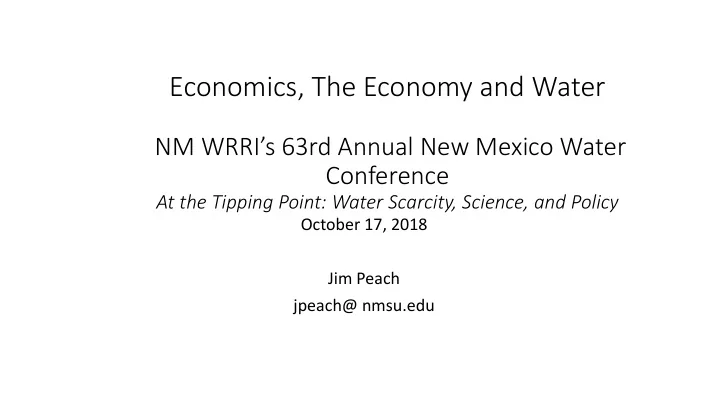

Economics, The Economy and Water NM WRRI’s 63rd Annual New Mexico Water Conference At the Tipping Point: Water Scarcity, Science, and Policy October 17, 2018 Jim Peach jpeach@ nmsu.edu
It’s the economy stupid-- or is it? Elephant Butte at 3.1% 10/14.2018 https://waterdatafortexas.org/reservoirs/individual/elephant-butte
The National Economy • 2018 Q2 RGDP increased by 4.2% • Probably 2.9% to 3.1% for the year • Good performance but hardly a record • Labor market performing well • Sept unemployment rate 3.7 percent • 96 months of employment expansion • Some weakness in auto sales and housing • Fed increasing interest rates –trade wars • Business cycle has not been abolished
The New Mexico Economy: better but … • Oil industry boom and state revenue surplus • Non-Farm Employment increased Aug 17 to Aug 18 by 1.96% • Best in years but still 2.9K jobs fewer than in Dec 2007 • Unemployment rate 4.6 % (Aug 2018) but … • Metro areas doing well except for Las Cruces • Top performing sectors (employment Aug 17 to Aug 18) • Leisure and Hospitality 4.7 • Professional and Business Services 4.5 • Construction 3.0
NM population growth reflects the state of the economy • From 2010 to 2017, NM population grew by 1.4% • 23 counties exhibited population declines • 27 counties with negative net migration • From 2016 to 2017, NM population grew by 0.13 % • 19 counties exhibited population declines • 20 counties with negative net migration
Photo by Jim Peach, June 2018
Water Shortage Price of water Supply Curve Shortage: Quantity demanded > Quantity supplied Demand Curve Quantity of water demanded
Elasticities Elasticities measure how responsive one variable is to a change in another variable. Price elasticity measures the responsiveness of quantity demanded to a change in price. Income elasticity measures the responsiveness of quantity to a change in income.
Price Elasticity ∆ % Q ε = % d ∆ P
Price Elasticity Baseball Card Example: The price of a card increases from 10c to 11c and the quantity of cards demanded decreases from 1,000 to 750. − ( 1000 750 ) / 1000 ε = = − 2 . 5 − ( 0 . 10 0 . 11 ) / 0 . 10
Price Elasticity • Price elasticities range from zero to minus infinity • A price elasticity of zero is called perfectly inelastic • A price elasticity between 0 and -1 is called inelastic • A price elasticity less than -1 is called elastic
Price Elasticity and Total Revenue Price Increase Price Decrease 0 <= Ed = -1 TR Increases TR decreases (inelastic) Ed = -1 No Change No Change (Unitary) Ed < -1 TR Decreases TR Increases (Elastic)
Note that the elasticity changes The relationship along the demand curve between price elasticity and total revenue Slope and elasticity are not the same
A perfectly inelastic demand Curve Price TR=PxQ Quantity
Some water demand price elasicities Place Year Elasticity Source Phoenix 2016 -0.36 (Single Family Residential) Fullerton (2016) -0.75 (Non-residential) Albuquerque 2012 -0.28 TO -0.48 (Households) Chermak et al (2012) 1998 -0.38 (Households) Gegax and McGuckin (1998) El Paso 1994- -0.32 (residential) Fullerton 2013 Las Cruces 1980-95 -0.07 (Residential) McGuckin et al 1998 -0.11 (Residential) Gegax and McGuckin 1998 Tucson 2001 to -0.20 (residential) Clarke, Colby, Thompson (2017) 2011
http://www.abcwua.org/education/consumers.html http://www.abcwua.org/education/pdfs/WaterUseGraph.pdf
Responsiveness to price changes • Are not instantaneous • Interact with non-price variables • Are not constant over time or geography • Are conditioned by income, household size, etc.
Various types of efficiency • Technical efficiency • Economic efficiency • Allocative efficiency • Scale efficiency • Dynamic efficiency • Pareto efficiency
Technical efficiency and economic efficiency • Technical efficiency is using the ‘optimal’ combination of inputs for a given level of production. Think of this in physical terms. If you are technically efficient, you can’t produce the same level of output with less of one input without increasing some other input. • Economic efficiency is not quite the same as technical efficiency. • Economic efficiency requires the least cost combination of inputs.
Allocative efficiency and Pareto efficiency • Allocative efficiency requires that the marginal social benefit of producing another unit of output is equal to the marginal social costs of doing so. • Pareto efficiency means that you can’t change the production of a good without making at least one person worse off. It is possible to have Pareto efficiency without allocative efficiency.
Some takeaways • The US economy is performing well but • There will be another downturn • The NM economy is showing signs of life but • It is mainly oil and gas • In economics a shortage has meaning only in relation to price • Water demand [rice elasticities are useful but … difficult • Efficiency can be defined in many ways
Thank you! Questions?
Recommend
More recommend